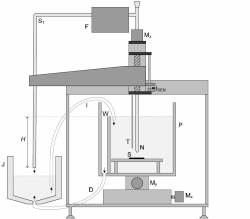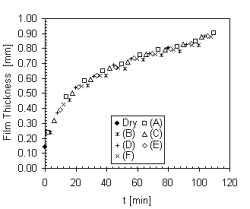 By monitoring the deposit thickness at several different points across the sample in a single experiment, the sFDG can generate much more data than previous FDG designs. This enables differences in swelling behavior across a sample to be identified, and conversely it is also possible to use a mosaic of different surfaces to study deposit-substrate interactions, again in a single experiment.
By monitoring the deposit thickness at several different points across the sample in a single experiment, the sFDG can generate much more data than previous FDG designs. This enables differences in swelling behavior across a sample to be identified, and conversely it is also possible to use a mosaic of different surfaces to study deposit-substrate interactions, again in a single experiment.
A computer is used to control x, y and z movement, as well as to record the siphon mass flowrate from a sensitive flowmeter. For the first time, this enables the actual operation of the gauge to be based on the current behavior of the sample. Specifically, the device uses a feedback system to alter the position of the nozzle depending on the mass flowrate. As such, it is possible to keep the nozzle-surface separation constant throughout an experiment, even if the sample is swelling rapidly. This in turn enables the forces (shear or normal) applied on the sample by the gauging flow to be maintained at constant, pre-determined values, or within a set range. Another new feature in the sFDG is the use of a telescopic siphon, which allows the shear forces imposed on the sample to be varied as desired, during the experiment. Currently the z-resolution of the sFDG is ± 5 μm, while operating temperatures from 10 - 50 °C and shear stresses in the range of 5 - 60 Pa are currently achievable.
Tracking Deposit Swelling During Cleaning-in-Place (CIP)
 The sFDG can track the swelling of a wide range of deposits during cleaning-in-place (CIP). Here the sFDG is being used to track the swelling of an initially dry gelatine film as it is soaked in RO water at 20 °C. Six different points (A - F) on the deposit surface are being monitored, with uniform swelling reported at each.
The sFDG can track the swelling of a wide range of deposits during cleaning-in-place (CIP). Here the sFDG is being used to track the swelling of an initially dry gelatine film as it is soaked in RO water at 20 °C. Six different points (A - F) on the deposit surface are being monitored, with uniform swelling reported at each.
From the shape of these swelling curves we can begin to infer the structural mechanisms responsible for the increasing deposit thickness, and hence better target these during cleaning.
Monitoring Deposit Strength During CIP

If the suction and shear forces applied by the gauging nozzle are gradually increased, at some point the deposit will begin to be removed. This can act as a characteristic measure of either the adhesive or cohesive strength of the deposit. The sFDG is able to scan across a deposit surface, taking a number of strength measurements within a single experiment. In addition, where a mosaic of different substrates is used, the adhesive strength can be compared for several nano-structured surfaces under identical conditions.
 Imaging Using sFDG
Imaging Using sFDG
 The scanning ability of the sFDG now offers the option of creating 2D surface profile images. The gauge scans across the surface, and measurement of the siphon mass flowrate gives the height of the nozzle above the surface at that point. At present each scan is relatively time consuming, and there is difficulty in resolving sharp edges. However, should an application for the imaging be identified, it is believed that both the resolution and the time taken for a scan could be improved relatively easily (by design). The key advantages of such an imaging technique are that is non-contact, does not rely on the physical properties of the surface, and can be conducted in completely opaque solutions or suspensions in situ.
The scanning ability of the sFDG now offers the option of creating 2D surface profile images. The gauge scans across the surface, and measurement of the siphon mass flowrate gives the height of the nozzle above the surface at that point. At present each scan is relatively time consuming, and there is difficulty in resolving sharp edges. However, should an application for the imaging be identified, it is believed that both the resolution and the time taken for a scan could be improved relatively easily (by design). The key advantages of such an imaging technique are that is non-contact, does not rely on the physical properties of the surface, and can be conducted in completely opaque solutions or suspensions in situ.

